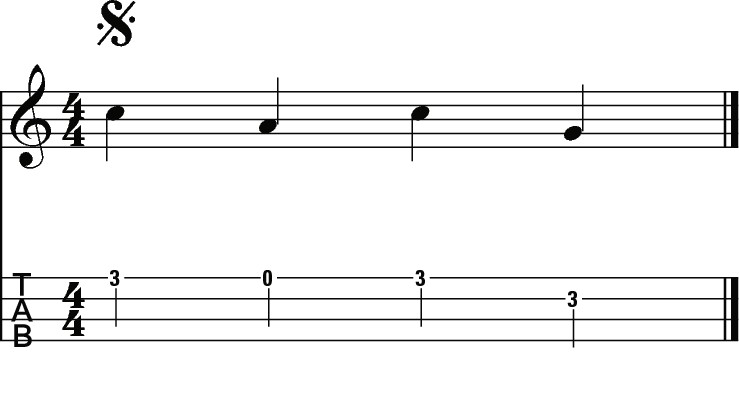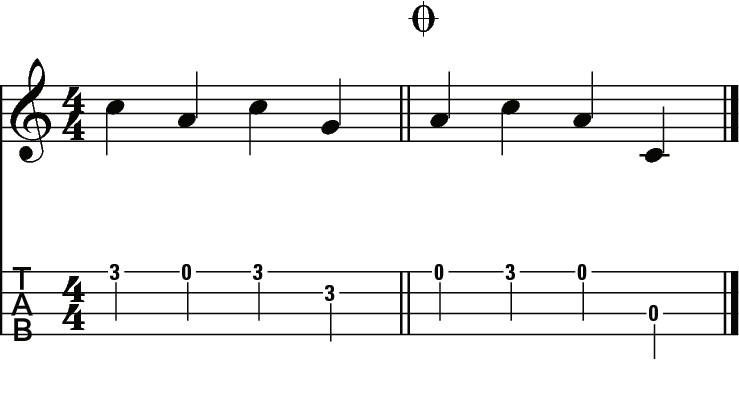Ukulele For Dummies (34 page)
Read Ukulele For Dummies Online
Authors: Alistair Wood


Figure 7-18 instructs you to play bars one and two before you hit the repeat sign. Then go back to the start, play those bars again and this time go past the repeat sign and play bar three.
If you need to repeat some bars more than once, both systems use a âx3', âx4' and so on above the repeat symbol.
If you have to repeat only a section (instead of going back to the beginning) you see a repeat sign the other way round at the start of the repeat section (see Figure 7-19).
Figure 7-19:
A repeated section: notation (top) and tab (bottom).

To play Figure 7-19, you play bar one, go straight past the right-facing repeat, play bars two and three, and then go back to the first repeat symbol and play bars two and three again before going on to play bar four.
Sometimes a repeated section ends a different way each time it's played. In this case you see a bracket above the bar or bars with a â1' in it before the repeat symbol (see Figure 7-20). In this situation, play the repeat as you have before but skip over the bracketed-off bars the second time you play and replace them with the set under the â2' bracket after the repeat symbol.
In Figure 7-20, you play bars one, two and three and then go back to the repeat and play bar two (the same as in Figure 7-19) but then skip bar three and go straight to bar four.
Figure 7-20:
Repeat with an alternative ending: notation (top) and tab (bottom).

You may occasionally see more complex repeats that are written in Italian (because otherwise mobsters would leave note heads in our beds!). The most common directions are:
 Da Capo (or D.C.):
Da Capo (or D.C.):
Go back to the start
 Dal Segno (or D.S.):
Dal Segno (or D.S.):
Go back to the sign (see Figure 7-21).
 D.C. al Coda:
D.C. al Coda:
Short for Da Capo al Coda. Go back to the start and carry on until you see the direction âTo Coda' and then head to the end (after a double bar line) where you see the sign in Figure 7-22.
 D.S. al Fine:
D.S. al Fine:
Short for Da Segno al Coda. Go back to the segno symbol and carry on until you reach the bar marked Fine, then stop.
Figure 7-21:
Segno symbol.

Figure 7-22:
Coda symbol.

Putting Everything Together
In this section I provide some examples of tunes that bring together the various elements of tab and standard notation that I describe earlier in this chapter.
You can find loads more on picking the strings in Chapter 8, but in the songs in this chapter I use my thumb to pick all the notes.
Starting with a simple tune
 Figure 7-23 shows a very simple example to start with: the old nursery rhyme âLondon Bridge Is Falling Down' (Track 24). You need to deal with only two different note lengths â half and quarter notes (minims and crotchets) â and all the notes are within the first three frets.
Figure 7-23 shows a very simple example to start with: the old nursery rhyme âLondon Bridge Is Falling Down' (Track 24). You need to deal with only two different note lengths â half and quarter notes (minims and crotchets) â and all the notes are within the first three frets.
For the fretting hand, fret each note as follows:
 First fret
First fret
=
Index (first finger)
 Second fret
Second fret
=
Middle (second finger)